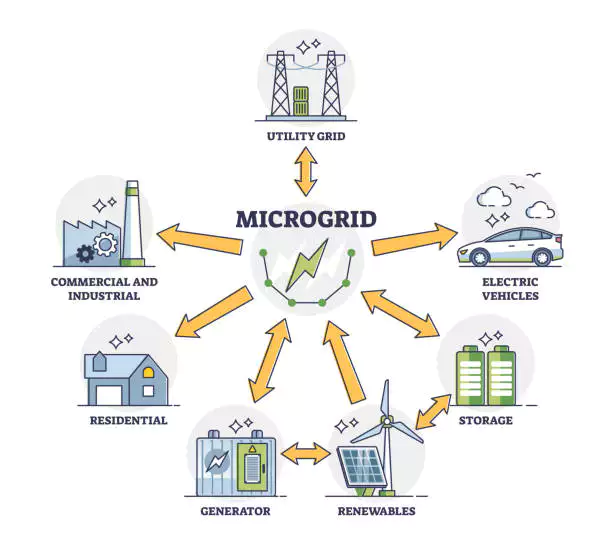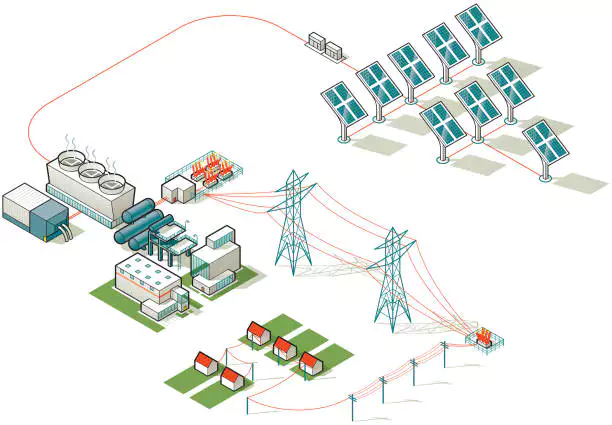Description
On-grid microgrids are a kind of local energy network that can work in coordination with the main power grid. It integrates distributed energy microgrid resources such as solar and wind energy (DERs) as well as energy storage systems, and achieves efficient power distribution through advanced microgrid controllers. Unlike off-grid microgrid systems, grid-connected microgrid systems can obtain electricity from the main grid when needed, ensuring the stability and continuity of energy supply.

Benefits of Grid-Connected Microgrid
Grid-connected microgrid technology brings multiple benefits to users, making it an ideal choice for modern energy management:
- Energy resilience: In the event of a grid failure, it relies on local resources and the support of the main grid to maintain power supply.
- Cost savings: Reduce electricity bills by optimizing energy usage and integrating renewable energy.
- Environmentally friendly: Utilizing renewable energy microgrids to reduce carbon footprints and promote green development.
- Flexible expansion: Applicable to various scenarios such as residential, industrial and community.
- Through the microgrid energy management system, users can monitor energy usage in real time, enhancing efficiency and reliability.
Typical Application Scenarios of On-Grid Microgrid Systems
On-grid microgrid systems are widely used in various industries to meet diverse energy demands:
- On-Grid Microgrid for Commercial Buildings: Grid-connected microgrids in commercial buildings ensure stable power supply and support daily operations.
- On-Grid Microgrid for Hospitals: The hospital microgrid provides reliable power supply for key equipment.
- Microgrid for University Campuses: The microgrid power system on the university campus supports teaching and research and promotes energy-saving goals.
- Community Microgrid Grid-Connected: On-grid microgrid systems promote energy sharing and local energy independence.
- Microgrid for Data Centers: The grid-tied microgrid in the data center ensures uninterrupted operation and efficient energy consumption management.
- On-Grid Microgrid for Residential Use: Grid-connected microgrids in residential areas provide homeowners with reliable, cost-effective energy and support integration with renewable sources.
- Industrial On-Grid Microgrid Solutions: Industrial microgrids ensure robust power delivery for manufacturing processes, enhancing energy efficiency and operational resilience.
- On-Grid Microgrid for Urban Areas: Urban microgrids support dense city environments by providing resilient, sustainable energy solutions and reducing strain on the main grid.

How On-Grid Microgrid Works?
Grid-connected microgrid systems achieve dynamic balance with the main power grid by intelligently integrating multiple energy components, providing users with stable and efficient power supply. The core lies in integrating renewable energy sources (such as solar photovoltaic panels and wind turbines), energy storage devices (such as lithium-ion batteries or flywheel energy storage), and advanced microgrid controllers to build a flexible energy ecosystem.
Under normal operating conditions, grid-connected microgrids monitor and optimize power distribution in real time through the microgrid control system to ensure the efficient utilization of energy. For example, when the solar power generation is sufficient, the system gives priority to using local renewable energy and stores the excess electricity in energy storage devices or feeds it back to the main power grid. During the night or low power generation periods, the system can seamlessly switch to obtain electricity from the main power grid, ensuring the continuity of power supply. This dynamic balance not only enhances energy utilization efficiency but also significantly reduces users’ electricity bills.
Distributed microgrids demonstrate strong flexibility and resilience during peak electricity consumption or when the main power grid fails. The microgrid controller quickly adjusts energy allocation through intelligent algorithms, prioritizing the use of local energy storage or renewable energy. When necessary, it can switch to “island mode” for independent operation to ensure power supply for critical loads such as hospitals and data centers. Meanwhile, the system adopts grid synchronization and power quality management technologies to maintain stable voltage and frequency and prevent equipment damage caused by power fluctuations.
The microgrid control system, as the “brain”, relies on sensors, communication networks and data analysis to monitor energy production, storage and consumption in real time and optimize dispatching. This intelligent management enables grid-connected microgrids to address complex energy challenges and provide reliable and sustainable power support for residential, commercial and community areas.

Cost and On-Grid Microgrid Installation Guide
The cost of on-grid microgrid systems is influenced by multiple factors, including system scale, component selection, and specific application scenarios. Energy storage capacity is one of the main cost drivers. The type of battery (such as lithium-ion, lead-acid or flow batteries) and capacity size directly affect the investment budget. In addition, the integration degree of renewable energy sources (such as photovoltaic and wind power) will also affect the overall cost. Systems with a high proportion of renewable energy may require more complex energy management systems (EMS). The degree of intelligence of the microgrid controller is equally crucial. Advanced algorithms and predictive functions can enhance efficiency, but they will also increase the initial investment. To ensure the stable operation of the system, installation must be carried out by a professional team. They are not only responsible for equipment deployment but also need to ensure seamless synchronization between the microgrid and the main grid, and comply with local grid norms and safety standards. We offer comprehensive cost assessment and installation guidelines to help customers optimize system configuration. For a detailed plan, please contact our technical team to obtain a customized analysis.
Why Choose Grid-Connected Microgrid Solutions?
Under the background of global energy transition, grid-connected microgrids have become an ideal choice due to their efficient and low-carbon characteristics. With the growth of electricity demand and the tightening of environmental regulations, traditional power grids are facing supply pressure and carbon emission restrictions. However, microgrids have significantly reduced their reliance on fossil fuels by integrating renewable energy sources such as solar and wind power. Grid-connected microgrids not only enhance energy autonomy but also switch to island mode when the main grid fails, ensuring continuous power supply for critical facilities such as hospitals and data centers. Whether it is an urban smart community or an area far from the grid, microgrids can be flexibly adapted, optimize energy distribution and reduce transmission losses. We have successfully provided microgrid solutions for multiple industries, covering areas such as industry and commerce, agriculture, and public facilities. For practical application cases, you can refer to our successful project reports to explore how microgrids can contribute to sustainable development.

Start Your Microgrid Project
If you plan to deploy smart microgrids for your residence, commercial complex or community, our team can provide end-to-end support, from feasibility analysis to system implementation. Grid-connected microgrids can not only reduce long-term electricity costs, but also enhance energy resilience and adapt to the challenges of electricity price fluctuations and extreme weather. We customize solutions based on customer needs, including energy storage optimization, renewable energy ratio design and intelligent dispatching strategies. The implementation process covers on-site assessment, scheme design, equipment procurement, installation and commissioning, as well as operation and maintenance training to ensure the efficient and stable operation of the system. In addition, we assist clients in applying for government subsidies or green financing to lower the investment threshold. Contact our advisory team immediately to obtain detailed cost estimates, return on investment analysis and implementation schedules, and take a crucial step in the energy transition.

